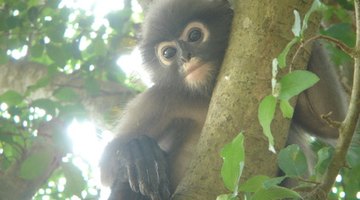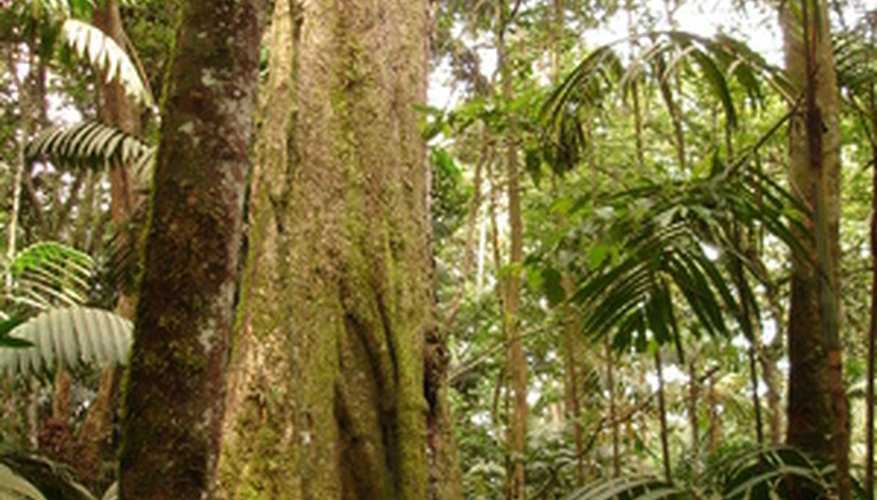The tropical rainforest is a wet, warm forest of trees that grow very closely together. The canopy (tallest tress) in the rainforest can release 200 gallons of water each year into the atmosphere. The resulting moisture hangs over the forest, keeping the interior warm and humid. Animals living in the rainforest have had to adapt to these wet, warm conditions and have had to find niches that allow them to thrive. They do this by altering species characteristics to fit the tall trees, the constant humidity and the quiet rainforest floor.
Primates

Monkeys and apes have adapted cleverly to tropical rainforests. All have long arms to use the canopy to swing through the trees, avoiding ground predators. The little aye-aye, a small Madagascan primate, has evolved to be a nocturnal feeder in order to escape the clutches of predators in the daylight. Its large eyes allow more light in at night, and it also uses echolocation to find its prey in the dark. The aye-aye takes advantage of tall rainforest trees to build his daytime nest for concealment out of the sight of rainforest floor predators. The aye-aye's oddly elongated middle finger evolved to scoop insects from small holes in tree bark where shorter fingers could not reach.
- Monkeys and apes have adapted cleverly to tropical rainforests.
- The little aye-aye, a small Madagascan primate, has evolved to be a nocturnal feeder in order to escape the clutches of predators in the daylight.
Birds

A study by Glenn Tattersall of Brock University in Ontario published by "The American Naturalist" in August 2010 showed that, on average across 214 bird species, 16% of a bird's beak size is accounted for by local annual minimum temperature. Beaks can be significant sources of heat loss, so birds living in tropical areas can afford to have a larger beak than if they were living in colder climes.
Predators

The South American jaguar, with its rich rosette camouflage, has developed the ability to swim well in its wet rainforest home. Adaptations of this sort allow the jaguar to find food not only on the ground but in the plentiful rivers and streams of the Amazon, in the form of fish, turtles and caiman. The jaguar has the ability to climb trees to ambush unsuspecting prey walking on the rainforest floor.
- The South American jaguar, with its rich rosette camouflage, has developed the ability to swim well in its wet rainforest home.
- The jaguar has the ability to climb trees to ambush unsuspecting prey walking on the rainforest floor.
A much smaller predator, the Amazon Horned Frog has developed a body that convincingly mimics "leaf litter." The frog uses its brown-green, leafy-looking body to lie amongst piles of dry leaves and ambush its prey for a lazy dinner.
Camouflage is very important to rainforest predators, as is lightning-fast speed when prey is in sight.
